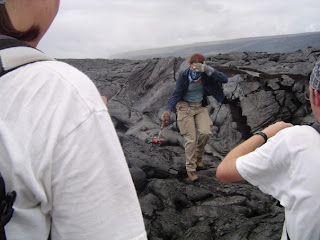Okay, maybe a little too much sarcasm there. I'm looking forward to seeing Boston, at any rate. If anyone's going to the conference, let me know - I'll tell you where I'll be set up!
Wednesday, March 26, 2008
Off to Boston
Okay, maybe a little too much sarcasm there. I'm looking forward to seeing Boston, at any rate. If anyone's going to the conference, let me know - I'll tell you where I'll be set up!
Tuesday, March 25, 2008
Kilauea's Halema'uma'u Crater producing ash plume
As of yesterday, the gas plume emanating from the explosion site in Halema'uma'u Crater on the summit of Kilauea has started to carry ash as well. They've put up a webcam on the roof of the Jagger Observatory, and it's a pretty cool view. (I am very jealous of the person currently visible in the lower right of the image.) Here's the USGS press release:
And here are some photos (you can see more at the USGS Kilauea page):Halema`uma`u gas plume becomes ash-laden
USGS HVO News Release
March 24, 2008There is now continuous emission of ash from the new gas vent in Halema`uma`u Crater, turning the formerly white cloud of fume a dusty-brown color. The top of the ash plume, which is currently being blown to the southwest of the Crater, reaches 0.5 to 1.0 mile above ground level. Hawai`i aviation agencies have been notified of the potential hazard to aircraft.
Last night, small incandescent particles were observed erupting from the vent below the Halema`uma`u Overlook. A few particles were ejected with sufficient velocity to be deposited on the rim of Halema`uma`u Crater. This morning, Hawaiian Volcano Observatory geologists reported finding Pele's hair, Pele's tears, and spatter in the overlook area, indicating that particles ejected overnight included molten lava-the first erupted from the new vent, which is now 30-35 m (100 ft) wide. The largest fragments of spatter, or blobs of molten rock, found on the crater rim are 10 cm (4 inches) in size.
The amount of lava erupted from the vent last night was small, but it represents the first lava erupted from anywhere in Halema`uma`u since 1982. Previous eruptions included lava flowing into the crater from fissure eruptions on its southwest rim in 1974 and 1971 and an 8 month eruption in Halema`uma`u in 1967-1968 that created a lake of lava that covered the entire crater floor.
The Hawaiian Volcano Observatory continues to monitor the activity. Photos, text updates, a new Halema`uma`u Crater webcam, and details about the Kilauea 1924 explosive eruption can be found at the HVO website http://hvo.wr.usgs.gov.


The vent is directly under the overlook, which seems to have taken some damage from last week's explosion. The Park Service has fortunately (or unfortunately, for volcano nuts like me) closed that part of Crater Rim Drive.
National Geographic News also has a short feature, and a different photo (hopefully taken with a telephoto lens) here.
Now I really, really, really want to be back in Hawaii. Why does all the interesting stuff have to happen when I'm stuck on the East Coast?
Monday, March 24, 2008
Accretionary Wedge #7: Geology/ists in the Movies
Or, as some of the commentary seems to lean toward, "How Hollywood manages to screw up, in movie and/or TV form, the science that it took me multiple years, pints of blood and continuing therapy sessions to learn, and why I can't be held legally responsible for my reaction when the students in my intro classes spout it back at me on exams."
Just kidding – but only a little. Geology in the movies seems to bring out both the passionate and the flippant in us. We mark geology movies as points of inspiration in our journey toward our chosen profession; we happily do our best MST3K impressions while tearing apart the shoddy science; we laugh at the absurdities and turn even the worst transgressions into teaching opportunities. Seeing your science represented in film can be both maddening and gratifying, and as a result this month’s posts cover the full spectrum of praise and pugnacity.
 I’ll be a little self-indulgent and mention my favorite geology movie (the video of which I’m currently ignoring in favor of writing this), the 1959 version of Journey to the Center of the Earth. I’m fond of all of the characters, even James Mason’s bellowing Professor Lindenbrook, but in my opinion, the real hero – and possibly the best geologist – in the movie is…Gertrude the duck. After all, it is Gertrude who discovers the proper entrance into the bowels of Mount Sneffels, Gertrude who enforces mine safety practices by removing stealing Madam Goteborg’s stays (which could have impeded her breathing), and Gertrude who, by being eaten by Count Sakneussem, leads the group to the Lost City of Atlantis and their volcanic escape route. (Okay, that was a stretch.) And Gertrude aside, Journey is just good campy fun. Giant mushrooms, dimetrodons, phosphorescent pools, lost cities, and singing geologists may be cheesy, but sometimes cheesiness is enjoyable for its own sake.
I’ll be a little self-indulgent and mention my favorite geology movie (the video of which I’m currently ignoring in favor of writing this), the 1959 version of Journey to the Center of the Earth. I’m fond of all of the characters, even James Mason’s bellowing Professor Lindenbrook, but in my opinion, the real hero – and possibly the best geologist – in the movie is…Gertrude the duck. After all, it is Gertrude who discovers the proper entrance into the bowels of Mount Sneffels, Gertrude who enforces mine safety practices by removing stealing Madam Goteborg’s stays (which could have impeded her breathing), and Gertrude who, by being eaten by Count Sakneussem, leads the group to the Lost City of Atlantis and their volcanic escape route. (Okay, that was a stretch.) And Gertrude aside, Journey is just good campy fun. Giant mushrooms, dimetrodons, phosphorescent pools, lost cities, and singing geologists may be cheesy, but sometimes cheesiness is enjoyable for its own sake.Had enough previews? Then it’s time for our feature presentation:
Just because you have a deep spiritual connection with volcanoes doesn’t mean you can predict eruptions, according to Chris Rowan of Highly Allocthonous. Hunches are often a good place to start, but unless you back up your gut feeling with a little science, people probably aren’t going to take you seriously. Not even if you’re Pierce Brosnan.
Chris at goodSchist takes us on a tour of the extreme geology to be found on the planet Crematoria in The Chronicles of Riddick. With a name like Crematoria and planet-wide explosive volcanic eruptions ever three hours, this place certainly isn’t going to beat out Cancun as a prime spring break destination – unless you’re a geologist, that is.
MJC Rocks at Geotripper gives us a who’s who of geologists in the movies, bringing together victims of volcanic eruptions, velociraptors, alcoholism, avalanches, and even a few who survive with only minor injuries. (Has Hollywood got a grudge against us or something?) There’s even a reminder that one of the most beloved fictional anthropologists, Indiana Jones, had his roots in a real-life extreme paleontologist.
Here’s something to look forward to – Journey to the Center of the Earth has been remade yet again! In 3D! With giant albino dinosaurs! And Brendan Fraser riding around in a mining cart! What could be better? Mel at Ripples in Sand hopes that the educational campaign accompanying the movie will be slightly more accurate than all that. (She also mentions The Great Warming, which seems to have slipped under the collective radar; I’ll put out a milk carton alert and ask, Have You Seen This Film?)
Some of us are lucky enough to be able to turn snarking into credit hours! John Van Hoesen has a class called “Geology in Film”, and brings to our attention some real classics of geo-cinema. Who knew Paul Newman did disaster flicks?
Not content to stop at a single entry, Dr. Mike at Otago has created an entire blog devoted to “Reel Geology”. Not to be missed is the entry for “Best Use of Mineralogy in a Movie,” awarded to The Monolith Monsters, which apparently features “a water-activated silica-sucking meteorite and ends with the hero saving the town by blowing up a dam conveniently located upstream of a salt mine.” ‘Nuff said.
Steve McQueen as a climate change prophet? Believe it. Callan Bentley at NOVAGeoblog gives us a lovely little tidbit from The Blob that suggests another excellent reason to step up our efforts to slow global warming…
Did you ever wish you could set the filmmakers straight? Well, Jim Repka at Active Margin might have done just that – however briefly. His close encounter with The Core may not have resulted in real science making it into the movie, but at least one anonymous writer now knows the meaning of gigapascal. (He also notes that nuclear weapons may be the next great innovation in seismology. Hmm...)
As a self-admitted Trekkie/Trekker, I was very happy to see the post by Silver Fox at Looking for Detachment about The Devil In The Dark, a Star Trek: TOS episode in which Kirk, McCoy and Spock encounter the galaxy’s first silica-based life form. Being able to mind-meld with a rock would be a fabulous asset for a geologist. Being a geologist on Star Trek, however, would not be so fabulous, as they tend to be relegated to the ranks of the Redshirts. (For those who aren't familiar with the Original Series, Redshirt = cannon fodder. Sometimes they even manage to kill them before the episode starts.)
Run for your lives – sedimentology is out to get you! Well, not really – but it is out to get Peter Parker in the next Spiderman movie, in the form of the villain Sandman. Thanks to BrianR at Clastic Detritus for the heads-up…and hopefully Imhotep from The Mummy won’t be too jealous.
Laelaps’ multimedia post brings us once again to the exciting world of extreme paleontology, where he explores the declining standards of the Jurassic Park movies; Professor Challenger, the first paleontological action hero in various incarnations of Conan Doyle’s The Lost World; and the likelihood that Cary Grant probably wouldn’t survive a real field camp, despite being Cary Grant. (Frankly, for high odds of survival in a dinosaur-ridden feature, I’d stick with Sam Neill, although he lost a lot of cred with that velociraptor duck-call in the third movie.)
Argus Panoptes at Astronomical Seeing points out why Ross of Friends makes a worse paleontologist than Cary Grant. (He is, indeed, way too well-groomed and lacking proper paleontological attire. One suspects that his field experience is mostly limited to obtaining beer in a crowded bar during a Yankees game, and not obtaining beer while camped in the middle of the Montana desert and trying to hide a secret scotch supply from a pack of ravenous graduate students.)
It's probably the one and only time a movie featuring a geologist has won any Oscars, let alone multiple ones. There Will Be Blood, featured in ZS's post at Hindered Settling, takes a look at the oil industry in the early twentieth century. It also explores the less charming side of geologists, and leads us to suspect that the main character may have forgotten his coffee supply, since he at one point looks for oil in a silver mine.
Last, but certainly not least, we have doomsayer Julian from Harmonic Tremors, who warns us that the big one is coming, and there’s nothing we can do about it. Fortunately, it’s not a monster earthquake but a movie about one – an incarnation of the novel 1906 by James Dalessandro, set during the San Francisco earthquake. Though it has its faults (I had to steal that one), including, refreshingly enough, too much science, Julian advises us to put our trust in Brad Bird and Pixar. (And yes, it would be really fun if a bunch of us geobloggers went to see it together – I’m game if you all are!)
Thank you all for your contributions – and for putting up with my own snarking, which has probably grown increasingly less witty and more random, since it’s getting pretty late where I am. Next up among the Accretionary Wedge volunteers is Andrew over at About.com Geology, who’s going to be hosting an Earth Day carnival – don’t forget to check the “Who’s hosting the next Accretionary Wedge” page for updates.
That’s all, folks!
PS - Apologies if I missed anything that was posted before the deadline; let me know and I'll add it on!
Friday, March 21, 2008
An appropriate situation for "ROTFL"
Thursday, March 20, 2008
New developments and a little history from Kilauea
The HVO has a wonderful account of the May 1924 eruptions here. Much of what they talk about, Don included in his tour, some of which I'll try to reproduce here (although there's no reproducing how wonderful a storyteller he is; if you ever get the chance to meet him, don't let him get away without talking about the history of geology at Kilauea).
To start, here's the scene of all the excitement; this was stitched together from photos I took during a gas sampling field trip.

The 1924 eruptions began in late April when the lava lake in Halema'uma'u drained, and the floor of the crater collapsed. This was followed by an earthquake swarm at the in the Eastern Rift Zone, near Kapo'o and Puna. The swarm subsided, but the crater floor continued to sink, going from ~115 m deep following the draining of the lake to more than 200 m deep. Avalanches were almost continuous, and enlarged the crater significantly. Finally, on May 11, the first explosions began to throw rocks and ash from the crater. These explosions went on until the end of May, and scattered debris in a large field all around the crater.
The part of the debris field we visited is across the road from the Halema'uma'u overlook. Here's the first of the craters, with Don Swanson for scale:

This surface forms when acid rain from the volcano dissolves SiO2 in the environment; the SiO2 is redeposited on the ground as opal, which cements the ash particles into a hard crust. Unfortunately, it's hardly gem-quality - but it's cool to know that you're walking on opal!
Many of the bombs in the debris field are very large, some of them weighing more than ten tons. This is the first example that we saw:
This particular bomb has some fascinating features. It's very dense, and it has a rind that shows miniature columnar joints, which means the rock was still hot when it landed.
It lacks a crater, which might lead someone to think that it was from the older debris field, but observers in 1924 noted that it was still hot when they encountered it. They concluded that the rock bounced or rolled away from its original impact site, which is now obscured. What I found impressive was the distance that this rock had traveled - hundreds, if not thousands of meters from the Halema'uma'u crater. It's not only the crater rim that's potentially dangerous, which is why park officials were very prudent to have closed the Crater Rim Drive (for that reason as well as the increase in gas output). Some of the observers of the 1924 eruption weren't so cautious:

We were a little more cautious in our observations than that photographer, who was in the process of picking up his camera and making a run for it.
As it turns out, Don enjoys geopuzzles as well. Here's a group of features that he invited us to speculate about:
They look like impact craters, but they're curiously lopsided, and they're not oriented toward the caldera. In fact, they weren't created by the volcano at all. Prior to the World War II, one of the fastest ways to get to Kilauea was to fly in, and this flat area served as an airstrip. After the attack on Pearl Harbor in 1941, these mounds were bulldozed onto the field to keep the Japanese from using the airstrip. (And to confuse future volcanology students, but I'm sure they kept that motive quiet at the time.)
Our last stop was at another large block on the debris field, this one better documented than the others. Here's a Don Swanson shot from 2006:
And here's a photo from May 22, 1924:

This block was thrown out of the caldera in an eruption on May 18, 1924, the same day that one of the victims of the 1924 eruptions, Truman Taylor, was fatally injured by explosion debris while retreating from the Halema'uma'u crater.
The recent explosion at Halema'uma'u is a fascinating new aspect of this episode of the Kilauea eruption. Not only did Pu'u O'o recently experience a flank eruption, which is a dramatic shift from the pali-cresting lava tubes of the past few years, but the main caldera also seems to be getting livelier, with a nearly four-fold increase in gas output and the first explosive eruption in more than 80 years. It's perhaps an indicator of a change in the magma chamber beneath the caldera, and it will be interesting to see if it leads to more explosions, or even a new lava lake in Halema'uma'u.
In which case I will be buying plane tickets, because there's no way I'm gonna miss that.
Monday, March 17, 2008
Just a reminder: Accretionary Wedge #7 is coming up!
The subject is Geology/ists in the Movies. What do you love, loathe, laugh at and ridicule about Earth science and scientists as Hollywood envisions them? Here's your chance to drag up the most obscure films you can find, or revive discussions of recent ones, and extol their virtues or castigate their failings as you wish. Ranting and raving encouraged!
Please have everything emailed, linked or commented on by 6PM Eastern Standard Time. I'll post up on Monday so you can all indulge in some post-Lenten-season movie-whomping!
If "xenolith" means "foreign rock", my dunites could be Irish
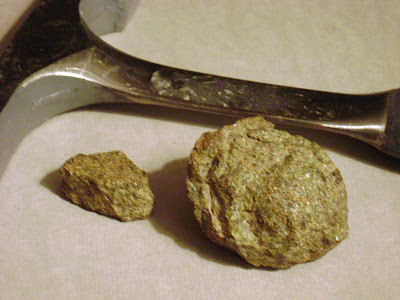

 Xenolith is a term that often gets associated with mantle rock, but it can mean any fragment of rock that was enclosed in another rock of a different composition during magma emplacement and eruption. Xenoliths are particularly valuable in that they can tell us what was going on in a magma chamber that experienced multiple injections of melt, or what kind of country rock magma was emplaced in, or what the mantle is composed of. They're like little green windows into processes that go on far below the Earth's surface - being erupted at a cinder cone in Arizona is only the very end of their story.
Xenolith is a term that often gets associated with mantle rock, but it can mean any fragment of rock that was enclosed in another rock of a different composition during magma emplacement and eruption. Xenoliths are particularly valuable in that they can tell us what was going on in a magma chamber that experienced multiple injections of melt, or what kind of country rock magma was emplaced in, or what the mantle is composed of. They're like little green windows into processes that go on far below the Earth's surface - being erupted at a cinder cone in Arizona is only the very end of their story.I'll make my next post a larger picture of the area where I found them - it's one of my favorite stops on that field course.
Wednesday, March 12, 2008
I hate mood swings
And you haven't.
I'd like to be happy for this person, but I am just the teensiest bit bitter to hear about their acceptance (AND paid visit), when this particular grad program has told me that they aren't accepting more than two people in my research area. (Which is the same research area that this person would be applying for.) So, is this person one of the two, or was the program just lying to make me feel better?
This being the same program that said they looked at people "years in advance". Arr. This person hasn't even graduated yet. How can the program have been considering them for that long?
!!!
...
I probably sound waaaay too excited for that kind of turnaround time.
Tuesday, March 11, 2008
How many licks DOES it take?
What would you add?
Friday, March 7, 2008
Friday Field Foto: I Saw the Sign...
After seeing Julian's photo of the Unsafe Rock Area sign (which I want), and Geotripper's collection of geology-related warning signs, I thought a good topic for today's Field Fotos would be some warning signs of my own. Most of them are from the Big Island of Hawaii (although I don't have any of the fault zone warnings, unfortunately), but my favorite is from the mainland. Here we go:
Wednesday, March 5, 2008
Alien Invaders

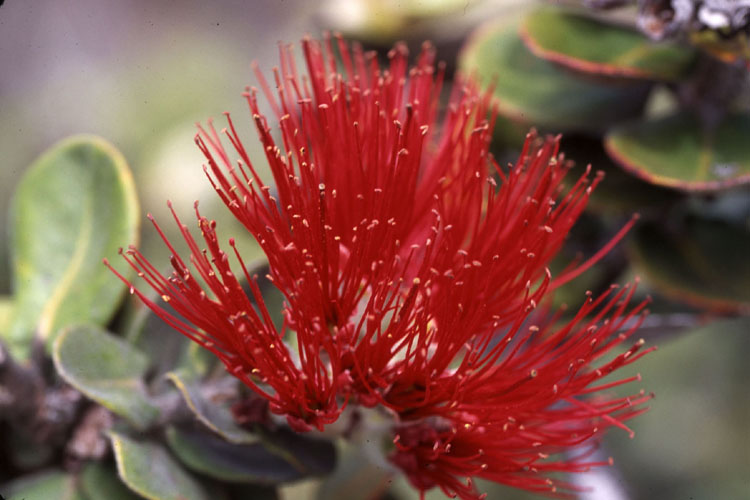
Plants aren't the only invasive species; wild pigs are notorious for destroying pretty much whatever gets in their way, wild goats strip bark from trees, rats eat bird eggs and carry disease, and feral cats prey on native birds and bats. One of the more ironic stories concerns mongoose; the Indian mongoose was introduced to the Islands in 1883 to deal with the rats, but instead became pests themselves without having much effect on the rat population (seeing as the mongoose is mostly diurnal and rats are nocturnal). And the cats didn't make a dent in either. (This does mean that there are scads of adorable, flea-infested kittens roaming most tourist sites, however.)
Interestingly enough, some of the few places that seem to have trouble with invasive species are relatively young lava flows. Because native Hawaiian species had thousands of years to adapt to the harsh conditions of fresh flows, they can get a foothold faster and more easily than nonnative species. One of the notable things about hiking on the flows, especially on Kilauea, is that 'ohia trees and 'ohelo bushes are often the only thing you will see growing (with maybe a few small ferns here and there). It's a small victory for the native plants, but an important one - and all thanks to the volcanoes. (See, I managed to work that in there.)
Further Reading:
Living dangerously...is totally fun
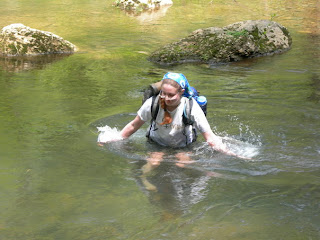 Okay, it's not death-defying (like Kim's water-related entry), but there were some death threats involved at the end of the day when we met back up with the prof who said, "Oh, you should ford the river there, it looks pretty shallow." Sure.
Okay, it's not death-defying (like Kim's water-related entry), but there were some death threats involved at the end of the day when we met back up with the prof who said, "Oh, you should ford the river there, it looks pretty shallow." Sure. Attack spiders are a big problem in the Texas desert.
Attack spiders are a big problem in the Texas desert.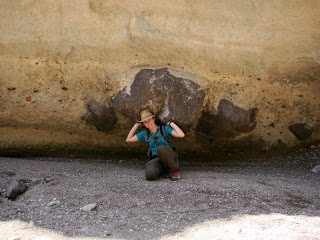 So are big rocks. (Granted, this mudflow deposit hadn't moved for a while, but that rock definitely could have...uh...been shaken loose by a freak earthquake.)
So are big rocks. (Granted, this mudflow deposit hadn't moved for a while, but that rock definitely could have...uh...been shaken loose by a freak earthquake.)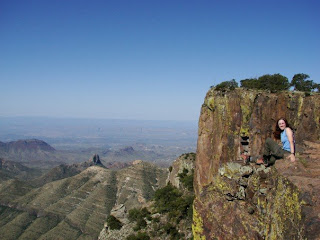 I have a bad habit of sitting on the edge of really high places.
I have a bad habit of sitting on the edge of really high places.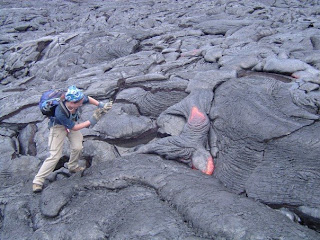 And of course, the obligatory crazy volcanologist photos - because who can really resist playing with hot lava?
And of course, the obligatory crazy volcanologist photos - because who can really resist playing with hot lava?